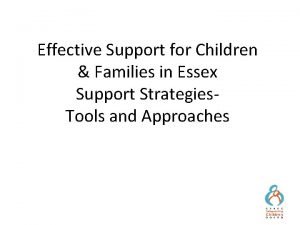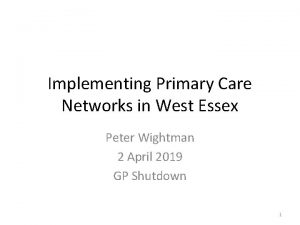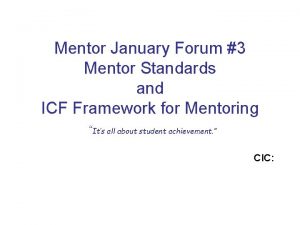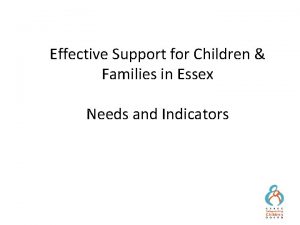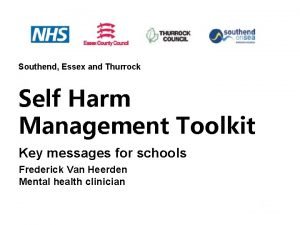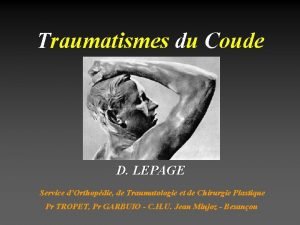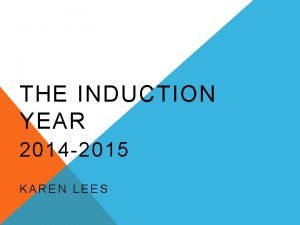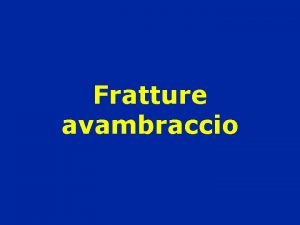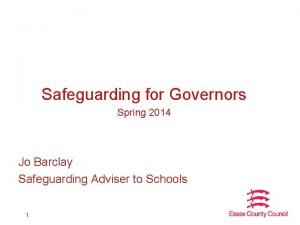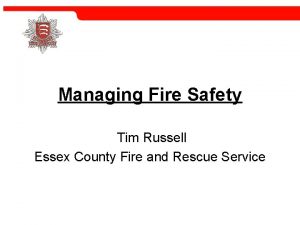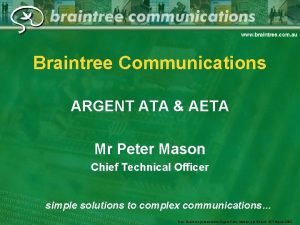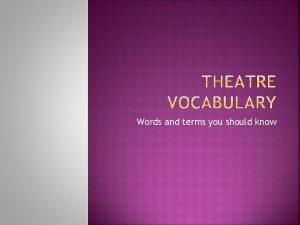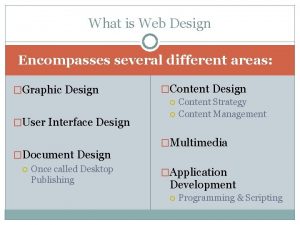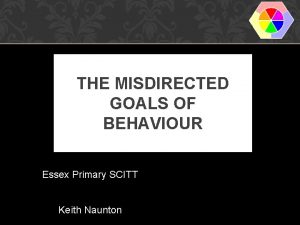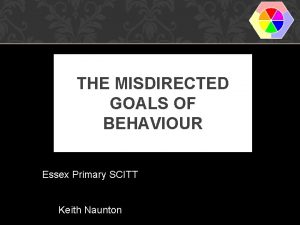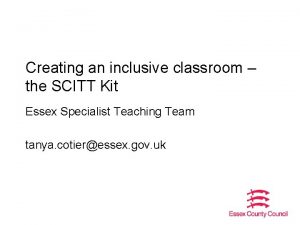Essex Primary SCITT Training Including children with a















































- Slides: 47

Essex Primary SCITT Training Including children with a hearing impairment Matthew Bysouth Lead Specialist Teacher & Educational Audiologist for Hearing Impaired Children Specialist Teaching and Preschool Service SEN/AEN Provider Services, ELS Essex County Council Telephone: 03330138261 | Mobile: 07825144548 Email: matthew. bysouth@essex. gov. uk | www. essex. gov. uk

Objectives for the session: • Understand the basic implications of deafness on educational outcomes • Understand the support that is available to teachers in Essex with deaf children in their class • Understand what successful inclusion/High Quality Teaching looks like for HI children

Essex Primary Schools and Deafness • As a primary school teacher you are 100% guaranteed to be teaching children who are experiencing a temporary hearing loss. • Permanent hearing loss in children is low incidence (1/2000) but the impact on outcomes can be very significant - 30% of deaf children achieve 5 GCSEs at A-C (65% of hearing children). • There are over 700 deaf children in Essex (deafness officially meaning anyone with a hearing impairment).

Essex Primary Schools and Deafness • 85% of deaf children in Essex are attend a non-specialist maintained school (or are pre-school). • 12% attend a school that hosts a specialist Enhanced Provision for hearing impaired children. These children have access to specialist staff onsite and a deaf peer group whilst attending a school alongside hearing children. • The Specialist Teacher Team employs a team of qualified teachers of the deaf who support schools in order to ensure the inclusion of their deaf learners. The provision of a local authority teacher of the deaf service is mandatory.

Specialist Teacher for Hearing Impairment – our website http: //www. essexlocaloffer. org. uk/listing/hearing-impairment/

Essex Provision Guidance http: //www. essexlocaloffer. org. uk/wp-content/uploads/2016/11/Provision-Guidance-v 3. pdf • Hearing Impairment section written by teachers of the deaf • Includes advice under the three headings – High Quality Teaching, Additional School Intervention and High Needs. • Each section includes detailed descriptions of hearing impairments and proven inclusion strategies for inclusion and successful outcomes. • Can be used to plan and audit inclusion and support. • Contextualises the support and provision put in place.

Hearing Loss • Every country in the world with an organised health care system has a screening programme for deafness. • In the UK there is universal screening at birth for hearing impairment. Why?

Hearing Loss • Language deprivation – which affects thinking, memory, literacy and outcomes • Early identification = early intervention = better outcomes.

The Ear

What can go wrong? Pinna

Types of Hearing Loss: Conductive Loss


Types of Hearing Loss Sensori-Neural Loss

The Practical Difficulties of a Hearing Loss t Children with a conductive loss hear all sounds, including speech, at a reduced level of loudness. t Children with a sensori-neural loss may only be able to hear distorted speech sounds.

The Audiogram – degrees of loss quiet LOUD Low High

The Audiogram – hearing test X=left O=right quiet X X X LOUD Low High

The Audiogram – hearing test X=left O=right quiet O O O LOUD Low High

The Audiogram – hearing test X=left O=right quiet X X X LOUD Low High

The Audiogram – hearing test X=left O=right quiet LOUD O Low O O High

Speech Discrimination quiet LOUD Low High

The Audiogram – typical moderate hearing loss quiet X=left O=right LOUD Low High

The Audiogram – typical high frequency hearing loss quiet X=left O=right LOUD Low High

Technological Support Hearing Aids




Technological Support BAHA



Trialling a BAHA on a soft band Permanent fitting

Technological Support Cochlear Implant

Internal Implant

However… None of this technology can make you hear ‘normally’!

Limitations of hearing aids § Cannot restore sound to normal level. They make sounds louder. Sounds, including speech, will still be distorted if certain nerve cells have been irreparably damaged. § Pupils will often mishear or misunderstand what is said – even in ideal listening conditions. § Despite sophisticated technology they cannot always select the most relevant or meaningful sounds from the environment. Unwanted background noise is still amplified. § Ineffective over more than 2 metres. Less than one metre is best.

Limitations of Cochlear Implants • The sound heard does not have a natural quality • It is difficult to listen in noise or at a distance • It is difficult to localise sound with only one implant but most children now receive two if their hearing loss requires it • Implanted children should avoid: - contact sports (and helmets should be worn for some other sports) - static electricity - certain medical procedures (eg MRI scans) - sand water

Common Difficulties • Children cannot always be within arm’s length of their teacher • Classrooms frequently have background noise • Some acoustic environments are impossible to improve A common solution to these problems is a radio aid system. Many deaf children in Essex schools use a radio aid.

What is a Radio Aid ? • A radio aid transmits the speaker’s voice directly to the hearing aid user without the sound being “lost” in the environment. • It consists of two parts 1. A microphone and transmitter worn by the teacher and 2. Receiver(s) attached to the child’s hearing aid(s)/cochlear implant(s)

Basic Classroom Strategies Visual Support for Understanding

Visual Support Seating Position: • Pupil should be at the front of the class • Better ear should be nearer teacher • What is the best position for: – 1: 1 – group – or whole class work?

Visual Support for lip-reading: • Ensure room is well lit • Avoid speaking in front of window • Try to stand still • Avoid speaking whilst writing on the board • Avoid covering your face or lips

Visual Support Are you giving supportive visual clues? • Write key words on board Key words • Use visual aids as much as possible • Write up instructions and homework details in full • Think of visual ways to clarify meanings of words

Visual Support Limitations of visual support: OR • Be aware that a child cannot lip-read and look at objects at the same time • Allow time for child to look after you have finished speaking • For older pupils: listening, watching and taking notes at the same time is impossible

Support for Understanding Check understanding: • Better to ask open questions than simply asking if child can hear • Check child is picking up group information and not just copying others • Set up a friend or ‘buddy’ to check that messages have been understood

Support for Understanding Managing class discussion / questions 1 st and answers: 2 nd • Identify each speaker clearly • Ensure one child speaks at a time • Summarise, review and recap main points • Pass around the radio aid microphone • Repeat other pupils’ answers 3 rd

Support for Understanding Working with an LSA/TA: • Give a copy of key vocabulary and concepts for topic/lesson ahead of time • Support their role in pre-viewing and reviewing work • Arrange for short withdrawal times in a good listening environment as appropriate • Set aside time for regular liaison

The impact of acoustics on immature language users Classrooms are traditionally noisy environments. Introducing sound soaking fabric blinds or curtains materials to all parts of the school will reduce background noise levels. cushions carpets and rugs Rubber feet for chair and table legs soft furnishings displays

The End Any final questions
 Essex scitt
Essex scitt Essex primary scitt
Essex primary scitt Essex primary scitt
Essex primary scitt Effective support for children and families in essex
Effective support for children and families in essex West essex primary care trust
West essex primary care trust Essex construction training
Essex construction training Iosh training essex
Iosh training essex Pcp scitt
Pcp scitt Scitt moir
Scitt moir Scitt moir
Scitt moir Science enquiry types
Science enquiry types Ctsn scitt
Ctsn scitt Ctsn scitt
Ctsn scitt Pathophysiology of tuberculosis
Pathophysiology of tuberculosis Shifts in poetry examples
Shifts in poetry examples Oates essex
Oates essex Ciacc essex county
Ciacc essex county Essex steps
Essex steps Effective support for families in essex
Effective support for families in essex Essex wessex mercia northumbria
Essex wessex mercia northumbria American hero poem
American hero poem Families in focus essex
Families in focus essex Hepscd
Hepscd Essex to berkshire
Essex to berkshire Joint meeting of essex and union counties
Joint meeting of essex and union counties Genesis student portal wems
Genesis student portal wems Self harm toolkit essex
Self harm toolkit essex 7 minute safeguarding briefings essex
7 minute safeguarding briefings essex Fairplay house essex
Fairplay house essex Essex infolink
Essex infolink Sindrom volkmann
Sindrom volkmann Luxation trans olécranienne
Luxation trans olécranienne Nqt manager essex
Nqt manager essex Anglo saxon england map
Anglo saxon england map Jo barclay essex safeguarding
Jo barclay essex safeguarding Essex infolink safeguarding
Essex infolink safeguarding Prono supinazione dell'avambraccio
Prono supinazione dell'avambraccio Talamo calcaneo
Talamo calcaneo Daniel pelka siblings
Daniel pelka siblings Fire risk assessment essex
Fire risk assessment essex Fha connection
Fha connection Herts and west essex stp
Herts and west essex stp Ata carnet essex
Ata carnet essex Magenta cyan and yellow are the ____ color. *
Magenta cyan and yellow are the ____ color. * Printed words including dialogue
Printed words including dialogue It encompasses several different aspects, including
It encompasses several different aspects, including Ice quotations
Ice quotations The mutcd states all workers
The mutcd states all workers



